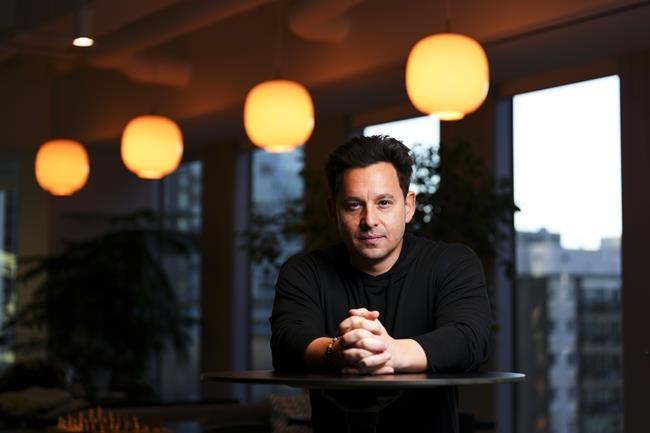When Kim Kardashian unveiled her beauty line SKKN with a Los Angeles mall pop-up in November, the world took note of her minimalist store, where concrete tissue boxes sold for US$89 and spheres of eye cream went for US$105.
But 4,500 kilometres away in Ottawa, the buzz around the shop had nothing to do with it being blanketed in muted tones or selling luxurious, vegan wares and everything to do with the Shopify Inc. system Kardashian used to process orders.
The tech giant's president Harley Finkelstein tweeted store photos and video of Kardashian playing cashier, writing, "We aren't just the ecommerce company - we are the retail everywhere company."
But as the company recently learned, "everywhere" isn't everything.
When the COVID-19 pandemic began and brick-and-mortar stores closed, big-name brands — Remy Cointreau, Crayola and Glossier — and pandemic-rattled small businesses flocked to Shopify. The interest pushed its stock up to an all-time high of $213 last November and inspired the hiring of 2,021 employees in 2021 alone.
The problem? Consumers weren’t forgoing in-person shopping for good, skewing Shopify's forecasts.
By this spring, the company long lauded as Canada’s top unicorn had seen its pandemic gains erased. Its stock price fell to roughly $50 and it laid off 10 per cent of staff — roughly 1,000 workers — in July with CEO Tobi Lutke taking the blame.
“They were planning for this sustained, e-commerce permanent step up in demand and that just wasn't really reflective of reality,” said Dan Romanoff.
But the senior equity analyst at Morningstar said Shopify isn't doomed.
“They’re just adjusting to a new normal.”
That's Finkelstein's view too.
"The past few years have been a time of incredible changes not just for commerce and e-commerce but for Shopify," he said, in an interview.
“We've had to make some tough decisions, obviously, last year, we had (job) losses...which are never an easy thing to go through, but one of the things that we've hopefully demonstrated to the world is that we're a company that is incredibly resilient.”
For Finkelstein, resiliency starts with making retailers — big and small — see his company as a one-stop shop.
"We really want more merchants to use more of our solutions," Finkelstein said.
That means getting retailers who power online stores with Shopify software to also use the company's point of sale hardware, seek funding from Shopify Capital and manage and deliver orders with its burgeoning fulfilment network.
Romanoff sees the network as a “no man’s land” because Shopify acquired several logistics companies to advance its shipping capabilities, but the venture only launched in 2019, so it hasn't reached full scale.
Plus, retailers have another option: Amazon.
The Seattle e-commerce behemoth wields cheaper prices and same-day shipping to dominate, making Rick Watson believe "Shopify is never going to try to match Amazon parcel for parcel and speed for speed."
But the founder of RMW Commerce Consulting suggests there's room for both, with Shopify catering to a customer base wanting relationships with brands or assurances about the authenticity of products they won't get from Amazon.
“There's always going to be this competition, this sort of natural tug of war between the two, but at the end of the day, they're both going to coexist,” said Romanoff.
Managing that coexistence will be a very different team than Shopify had two years ago.
On top of laid off employees, key staff who shaped the company — chief financial officer Amy Shapero, chief operating officer Toby Shannan, chief product officer Craig Miller, managing director of revenue Ian Black, director of product marketing Arati Sharma — departed during the pandemic too.
Finkelstein, who used the pandemic to build a tea company with DavidsTea's founder, chalked it up to "different people, different life plans."
"There's sort of tours of duty and not everyone wants to be on this next tour," he said.
However, he's excited about the next tour. Vice-president of product Kaz Nejatian will take over for Shannan and Jeff Hoffmeister, who Finkelstein was "dreaming of working with since 2014," will assume Shapero's role.
Watson feels Hoffmeister, who led Shopify's initial public offering and worked for Morgan Stanley since 2000, was hired to “manage Wall Street."
That will mean maintaining investor confidence in a company that slipped out of a profitability and by Romanoff’s estimates, is unlikely to meet that threshold by the end of this year.
Yet he's confident the company can get back there and perhaps even retrench some of its stock losses.
Finkelstein said the stock plunge "hasn't been too much of a distraction" because executives have been "thoughtful" around how they address it. (The company has long kept workers from dwelling on it by encouraging staff caught checking it too often to treat their team to Timbits.)
"Look, the stock is up 20 per cent in a couple of weeks. It doesn't mean we got 20 per cent better, but it also means when it's down 20 per cent, it doesn't mean we got 20 per cent worse," he reasoned.
"In the short-run, it doesn't actually make any sense... It's sort of a popularity contest, but in the long run, it does reflect the true value of the company and we're in this for the long run."
Instead, he judges Shopify performance based on its culture and share of the e-commerce industry. By his count, Shopify powers 10 per cent of all U.S. e-commerce.
"That would make us the second largest online retailer in America," he added.
But he's not content to stop there and based on his timeline, believes Shopify has more than enough time to nab an even large share.
"We always said we want to build a 100-year company and we have 84 years left."
This report by The Canadian Press was first published Dec. 13, 2022.
Companies in this story: (TSX:SHOP)
Tara Deschamps, The Canadian Press



